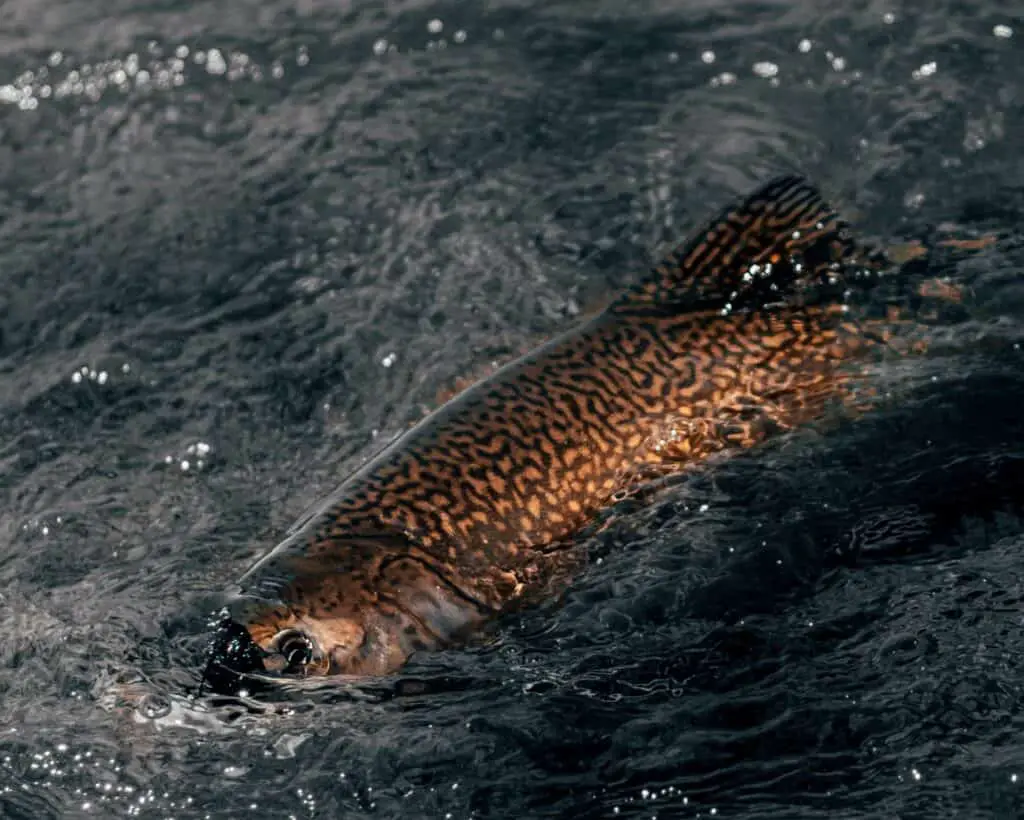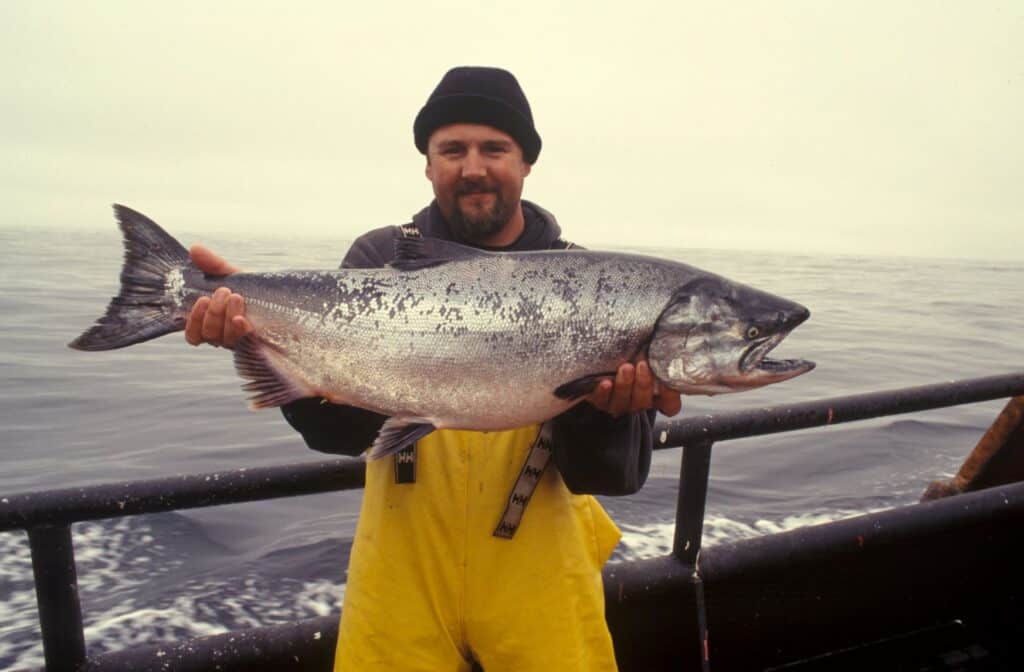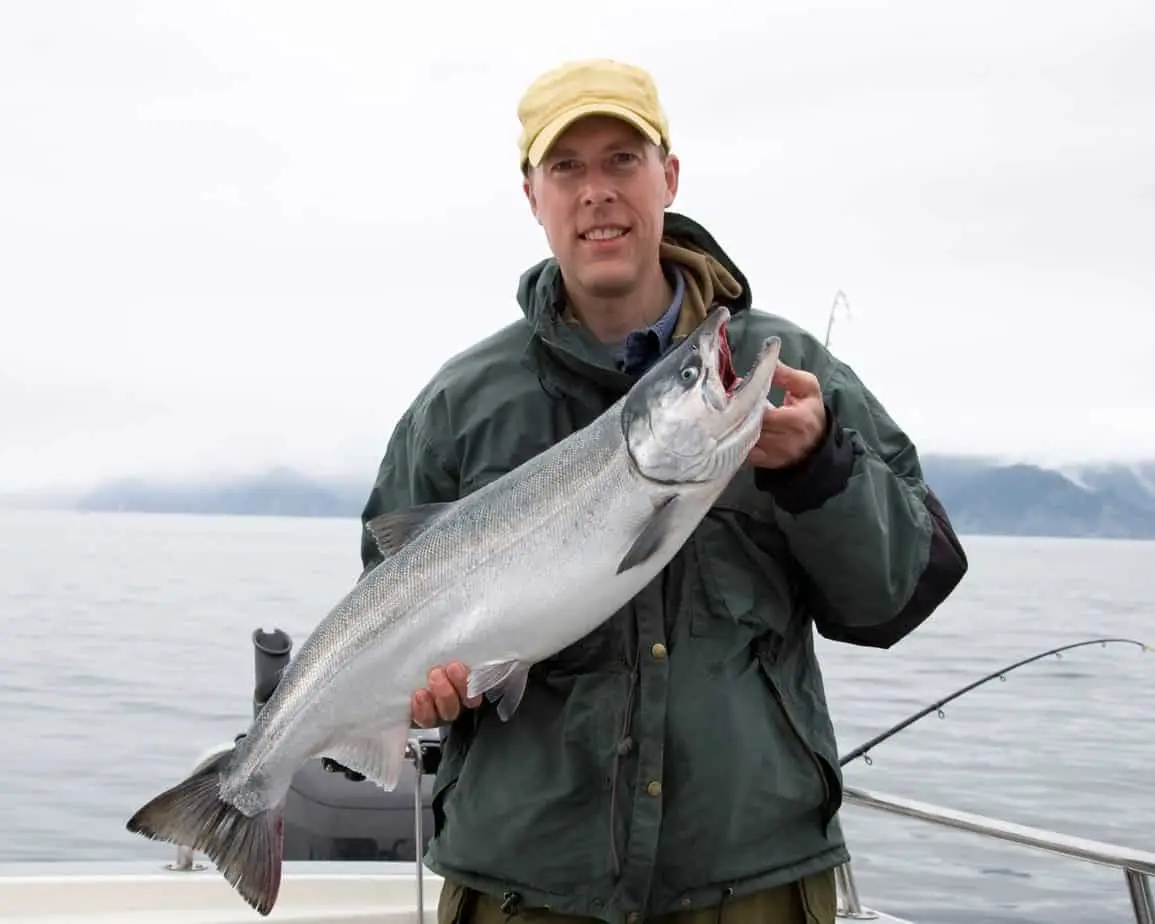These are two of the most popular game fish on the planet and are closely related. Despite the close relationship, there are fundamental differences between the two species. This article sets out to explore these and give you some useful hints and tips about catching and identifying the two fish types.
So what’s the difference between trout and salmon?
The main factors that differentiate trout and salmon include habitat, spawning, breeding, size, and feeding habits. We shall examine these in detail further on in the article. But a simple definition is: Salmon live mostly in the sea and return to their home river only to breed; trout usually are freshwater fish that reside in lakes and rivers.
Of course, there is far more to it than that. Appearance, weight, subspecies, and more all need to be explored to get a true understanding of the difference. So, if ever you’ve woken up in the middle of the night pondering this very question, then you have come to the right place.
Main Differences between Trout and Salmon
There is no simple answer to this; even between individual members of the trout family and the salmon family, there are differences. However, on average, Salmon are the larger of the two species and can usually be identified by having a sharper shaped head than rounder headed trout.
It gets more complicated when you start to look at DNA. According to tests in 1989, Rainbow and Steelhead Trout are actually Salmon, and Atlantic Salmon are actually trout. For the purposes of this article, we will stick with the classical definitions.
To really understand the differences, it is useful to list the most common members of both families.

Species of Trout and Salmon Native to the Western USA
Four other distinct salmon species range along the length of this coast from California to Alaska. The Species are:
Chinook Salmon (King Salmon)
These are the biggest and the most widespread of the salmon family. They range along the entire coast and can weigh over 100lbs and be over 5 feet in length.
You can recognize a chinook salmon the easiest way by looking at its mouth, chinook salmon have black gums, and the entire inside of their mouths are also black. Hence Chinooks are often referred to as Blackmouth Salmon.
World Record: 97lbs 4oz, Alaska, 1985
Pink Salmon
This one bucks the trend of salmon always being larger. These are the world’s smallest salmon and are also characterized by having unique spawning habits. In even-numbered years they spawn in Alaska. In odd-numbered years, they spawn in Washington and British Columbia, one to watch for if you’re planning a fishing trip for this tasty fish.
As the name suggests, this salmon can be identified by its pinkish hue. During spawning season, they also grow a large hump.
World Record: 14lbs 13oz, Washington State, 2001
Coho Salmon (Silver Salmon)
Not as large or as numerous as the Chinook salmon but are renowned amongst the angling fraternity because of their fight when caught. They don’t range as far south as the chinook and can be found from Washington State Northwards.
For identification, these salmon also have black mouths. However, their gums are white. When spawning, these fish also turn a deep red with a black head and tail that makes them unmistakable. Males also grow a ‘Kype,’ which is a long hook-shaped nose.
World Record: 33lbs 4oz, New York, 1989
Sockeye Salmon (Red Salmon)
These are said to be the tastiest of all Pacific Salmon. This species has the same distribution as the coho salmon and some of the same identification traits.
Usually, these can be identified by their golden eyes (hence the name). They also have larger eyes than the other species of pacific salmon. When spawning, the males grow a large hump on their back, and they also turn vivid red with a green head and tail.
World Record: 15lbs 3oz, Alaska, 1974
Chum Salmon
Probably the least known and least fished for species. Anglers generally won’t target this fish as they don’t fight well. It is another fish that sticks to the Northern States and Canada. However, unlike the other species, these are not present in the Great Lakes.
It can be identified by its white mouth and subtle stripes that run the length of its body. When it spawns, it is unmistakable. It turns a spooky green with vivid purple stripes, and it also grows a hooked nose.
World Record: 35lbs, British Columbia, 1985
Next, we will have a look at the two main Trout Species.
Rainbow Trout
Now widespread throughout the States and, indeed, the world. This is the trout that you are likely to see for sale in the shops. Easily identifiable by their black spots and the pink stripe that runs the length of the fish. There are a few subspecies of this fish, including the golden trout and the Redband trout.
World Record: 48lb, Canada, 2009
Cutthroat Trout
Not as well known as their rainbow cousins, but this another trout that is natural to the western states. Their name hails from the distinctive red flash behind their lower jaw. This is a much-varied species with some 11 subspecies identified, many only found in a specific lake or river.
World Record: 41lb, Nevada, 1925
These are the main species that are native to the western USA. There are a few other native trout, including Apache Trout, Seagoing Cutthroat Trout, and Steelhead Trout (Seagoing Rainbow).
Species of Trout and Salmon Native to the Eastern USA
The western USA is spoiled when it comes to members of the salmonid family. The east coast only really has two members to speak of. What they lack in numbers, though, they make up for in quality.
Atlantic Salmon
Found along the US’s eastern seaboard and much of Europe, this fish was almost fished to extinction. Most Atlantic salmon is now farmed raised. It is a prime but rare catch for anglers these days but well worth putting the effort in if you ever have the chance to target these beautiful fish.
These are easily identified by the large dark spots on their gill covers and the y or x shaped spots that adorn their backs.
World Record: 79lb 2oz, Norway, 1928
And that is pretty much it for the eastern salmon. Next, we will look at the major native trout species of the eastern seaboard.
Brook Trout
Native to North-East USA, these trout tend to be on the smallish size. On average, they weigh between 1 and 2lbs and will rarely reach double figures. Despite its name, the brook trout is actually classified as a char.
They are easily identified by their unusual, dappled patterning across their backs and white markings along the edge of their fins.
World Record: 14lb 8oz, Ontario, 1915
While that covers the US’s main native species, one more species should be considered when discussing trout and salmon differences.
Brown Trout
These are European Trout that now flourish after being introduced across much of the USA. Because of their shared heritage, they are more closely related to Atlantic Salmon than US trout Species.
Easily identifiable by their brown and sometimes golden color, these are unmistakable when compared to native species.
World Record: 42lb 1oz, New Zealand, 2013
There are so many species and subspecies and hybrids that it is simply impossible to list them all, so apologies if we have missed your favorite species.

Different Fishing Tips and Techniques for Trout and Salmon
This section shall briefly discuss some of the things you need to know before setting out to fish for trout and salmon.
When to Fish for Trout and Salmon
There is no one answer to this. For trout, many states are open all year round. Some may remain open for certain species only. It is well to check this before planning any outings. A general rule of thumb is that trout fishing is better overall in the spring and fall.
Salmon varies from river to river depending on the timing of their spawning run. Before planning any salmon outing, the safest bet is to establish this well in advance, particularly if you’re planning a trip.
How to Fish for Trout and Salmon
These are sought-after game fish, and many anglers insist that the true way to fish for this species is by a fly. Indeed, many fisheries restrict fishing to this method, and it is certainly successful. It is impossible to list recommended flies to use as there are too many species and areas to cover. If you are a fly-angler, you are always best to check local knowledge wherever possible.
One difference between the two disciplines is that with trout fishing, you are generally trying to ‘match the hatch’ that is luring your prey using imitations of whatever insect they are feeding on. It is more a case of triggering an aggressive reaction by ‘irritating’ it with your lure with salmon.
For bait anglers, a whole range of baits work for trout, including nightcrawlers, grubs, spinnerbaits, and even bread can work. For salmon, try shrimp and even salmon eggs.
Conclusion
The Salmonid family consists of a large and complicated family tree, and the lines are sometimes blurry, as we have established. But one thing is certain, the world over, they are amongst the most sought after of all fish by anglers. They are almost without exception a stunningly beautiful and hard fighting family and worthy of our highest respect.
We hope you enjoyed this article. If you’d like to be kept up to date with all things angling related and never miss similar content, then why not sign up for our newsletter.
If you find this article helpful, don’t leave without sighing up for our newsletter and checking out our Recommended Fly Fishing Gear List.
Don’t forget to check out our other Fish Guide articles.
- Are Bass Good To Eat?
- What’s the Difference Between Trout and Salmon?
- Are Bonefish Good To Eat?
- What’s the Difference Between Carp and Buffalo Fish?
- Are Pike Good To Eat?
- The 7 Best Secret Rainbow Trout Baits
- Best Powerbait For Stocked Trout
- What Is The Difference Between Walleye And Pickerel?
- What Is A Tiger Trout? Where to Find One and How To Catch One


